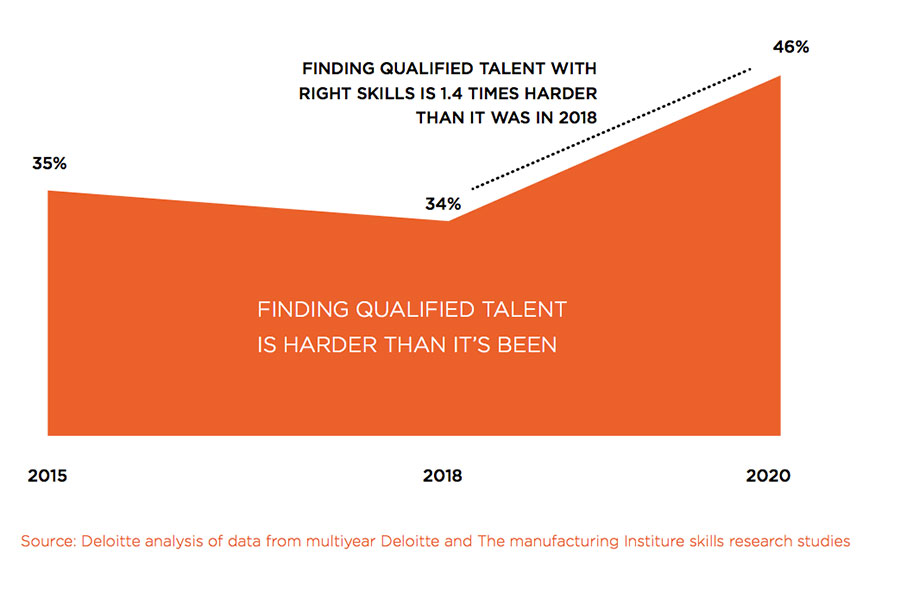

Homa's philosophy revolves around continuous evolution, rooted in the belief that the most critical asset for a company is its people.
CEO Michael Yao underscores this commitment, expressing confidence that investing in talented individuals signifies a path to success and profitable growth. The company's strong corporate culture is built on trust, skills development, and ongoing investment in its people.
Care is at the core of Homa's values, driving a commitment to an equal and inclusive working environment. Actively empowering women, Homa fosters awareness of abilities and aspirations, breaks down cultural barriers, and champions equal opportunities.
Key Takeaways:
1. Workforce Gaps:
- The rise of "Quiet Quitting" and "The Great Resignation" signals a radical reassessment of work post-Covid.
- Changing expectations demand leaders address the disconnect between employee desires and traditional work patterns.
- Surveys highlight the preference for remote work, posing challenges for leaders aligning with employee expectations.
2. Supporting Employees for Sustainable Performance:
- Company culture emerges as a top concern for leaders managing hybrid work models.
- Managers play a pivotal role in connecting employees to corporate culture, requiring updated skills.
- Wellbeing and supporting Generation Z emerge as critical areas needing proactive employee measures.
3. The Workforce Scenario in Manufacturing:
- Challenges such as unexpected events, climate change, and material shortages impact supply chains. To stay competitive, companies focus on factors they can control, including digitisation, stock management, supplier relationships, and talent acquisition.
4. Reasons for Unfilled Roles:
- Work-life balance concerns during and post-Covid impact manufacturing, leading to early retirements and job changes.
- Deloitte study highlights well-being as a top trend but a shortcoming in the manufacturing industry.
- Employee satisfaction and fulfillment linked to remote work options.
5. Managing Workplace Gaps in Manufacturing:
- Diversity, Equity, and Inclusion (DEI) play a crucial role in attracting and retaining employees.
- DEI metrics linked to leadership performance enhance cultural change.
- Unfilled job openings impact production, innovation, and market responsiveness in manufacturing.
6. Talent Attraction and Retention
- Evolving talent management approaches, community engagement, and AI in recruitment are crucial for manufacturing.
- Internal talent movement, upskilling, and supporting employees through digital fluency are essential.
- Flexibility/adaptability, alongside digital skills, emerges as critical for the future manufacturing workforce.
Regarding market responsiveness, Homa takes concrete actions to meet evolving demands, enhance capabilities, and foster an inclusive workplace.
Celebrating achievements, such as having 53% female managers in the IBC, Homa emphasises competence and knowledge as the means to break through barriers like the "glass ceiling."
Homa continues to invest in and analyse the worldwide labour scenario to maintain and develop its culture knowing that today work landscape is marked by turbulence as organisations grapple with the repercussions of the disruptions caused by the pandemic.
Leaders and HR departments are caught amid emerging trends and intensified challenges, particularly in employment. The workforce, with altered expectations post-pandemic, is reshaping traditional notions of work, adding pressure on leaders to navigate the evolving competitive talent panorama.
In this dynamic environment, the need for innovative solutions becomes apparent. This post delves into the profound shifts in the workforce, scrutinising overarching trends and, more specifically, how they impact the manufacturing sector worldwide.
Organisations in all business areas continue to face significant employment challenges.
They see a workforce with different expectations post-COVID-19, which results in pressure on how and when employees want to work, which feeds into the prevailing competitive talent panorama.
This workforce needs different kinds of support around welfare and training than before the pandemic. Leaders and managers may need to prepare to intervene in these areas, thus risking further talent attrition.
These challenges are taking place when the pressure to control costs is very high and where advances in digitisation, artificial intelligence, and automated processes continue apace, bringing advantages and hurdles to overcome.
Let's take a more in-depth look at these trends in general and then examine how they affect the manufacturing sector more closely.
Workforce gaps
There is debate about whether the 'Quiet Quitting' movement is a natural phenomenon or a trendy phrase invented by the media and social commentators.

In Quiet Quitting, the worker does not leave their job but does the minimum required to get it done, including not engaging outside work hours. This label may be a recent interpretation of a trend of worker dissatisfaction before COVID-19, which was exacerbated by the pandemic, as many employees reassessed their lives and their relationship with work.
There is no doubt, however, about the other phenomenon related to this radical reassessment by workers, 'The Great Resignation', which had been a significant contributor to the large number of unfilled roles.
A term coined in May 2021, The Great Resignation describes the record number of people leaving their jobs since the beginning of the pandemic. Some took early retirement, while many readjusted their ideas of how they wanted their personal and work lives to intersect and significantly changed how they earned their living.
Even for those who remained in their jobs and whose roles enabled them to continue to work remotely, the experience of home working convinced many that they did not wish to return to working in the office full-time.
A March 2022 survey by PwC, Global Workforce Hopes and Fears, carried out on more than 52,000 workers in 44 countries and territories, found that while pay was still the main factor in why people want to change jobs, fulfilment and the ability to be one's true self at work were ranked second and third among employees considering a job change, with work flexibility also of increasing importance.
These changing expectations, which in 2023 have expanded and seem to be here to stay, are putting pressure on leaders and managers to find ways to manage the apparent disconnect between what employees want and traditional pre-pandemic work patterns.
In the PwC survey, 26% of employees said they would prefer full-time remote working, but only 18% said their employer was likely to adopt that model. In comparison, another 18% said their employer could require full-time in-person work, which just 11% of employees preferred. Also supporting this view of a disconnect between employees and executives was a November 2021 survey by Gartner of more than 3,500 employees revealing that less than half believed remote working was de-stigmatised at their organisations, while 70% believed on-site workers were more likely to be promoted and paid more compared to remote workers.
The Gartner Survey also found that the consequences of this clash of expectations were severe: 52% of employees stated that work policies would impact whether they stay at their organisations, with 16% willing to quit their current job if required to work entirely on-site, and 8% saying they would leave if needed to work even partially on-site.

Supporting employees for sustainable performance
In the face of these vast changes, leaders are rating company culture as their biggest concern regarding in-office and work-from-home policies and are working with HR leaders to manage the complex challenges of adjusting their current culture to support the workforce. Full or part-time homework has increased the pressure on low to mid-level managers because these people are the colleagues with whom their direct reports most regularly interact.
In a Gartner report on future work trends, 60% of hybrid home and office employees said their direct manager was their most direct connection to company culture.
These managers urgently need support and training to update their managerial skills in line with today's needs, ensuring that they are clear about their priorities and how to practically implement corporate strategy in their day-to-day dealings with their reports.
Two areas that have changed post-pandemic, where organisations are finding a need to take proactive employee measures to help support and retain talent, are well-being and supporting Generation Z new hires.
The pandemic has impacted many people's mental health, so employers are finding that they need to provide more opportunities for open discussion and support among their workforce and to coach managers on workplace conflict resolution.
The young new hires of Generation Z missed out on crucial moments of growth in the social and educational sphere, so they may need more soft social skills, such as networking, speaking confidently in public, and negotiating, which gives them confidence in the workplace.
Supporting 'the whole person' at work in this landscape is not a 'nice-to-have' but a pathway to retaining talent and sustainable performance.
The workforce scenario in manufacturing
"We can't find the people to do the work". A Deloitte Insights study, 'Creating Pathways for Tomorrow's Workplace Today', surveyed over 800 US manufacturers from organisations of all sizes and sectors in two online surveys between December 2020 and February 2021.
77% of manufacturers surveyed anticipated ongoing difficulties in attracting and retaining workers in 2021 and beyond. The survey revealed two critical aspects that define the industry's immediate shortages: the challenge of entry-level positions and the difficulty of finding skilled talent. The entry-level roles are those that do not require technical know-how or industry knowledge but instead need common sense and an ability to listen, learn and follow through. Sources for these roles could be school leavers or people moving from other industries, such as hospitality or the food services sector. Still, the survey indicated this movement was not happening despite starting wages in US manufacturing higher than local minimum wage levels.
The second area where manufacturers need help filling jobs is among middle-skilled roles. These roles demand more experience and specialised skills and may involve further training, licencing and certifications.
The third and most significant challenge for the manufacturing sector is the continuous rapid development of digital transformation across the industry.
The skills needed to do many of the jobs in a smart factory will need a far more excellent knowledge of programming, Augmented Reality (AR) and Virtual Reality (VR), Artificial Intelligence (AI), high-level data management and so on than many current workers possess. Attracting and retaining suitable candidates for these new roles is a crucial challenge for the industry. Without changing the skills composition of the workforce, US manufacturers could leave up to 2.1 million jobs unfilled between 2020 and 2030, impacting everything from productivity to innovation and competitiveness to GDP.
Reasons for unfilled roles
Like the broader employment picture, manufacturing is experiencing workers reassessing their work-life balance, as they may have been temporarily or permanently laid off or faced difficult personal choices around work and family commitments during lockdowns.
Some who could retire early made that choice or began planning for it sooner than expected. Others saw opportunities for a different type of work in warehousing, distribution and home delivery as online shopping exploded, areas where there are more opportunities for flexible schedules and better work-life balance.
In fact, candidates now have different expectations for entry-level and higher positions for jobs and careers.
In line with other studies, the 2020 Deloitte Global Human Capital Trends study defined well-being as a top trend cited by 80% of respondents across industries. However, it is also the area where respondents believe manufacturers fall short, and work-life balance is the top reason respondents are considering leaving the manufacturing industry.

Of course, people need to work, and where there are jobs available in manufacturing, they will take them if there is no other choice.
But unless manufacturers find ways to make the workplace more fulfilling and accommodating to employees' needs, they will likely move on at the first opportunity for something that suits them better.
In the PwC Global Workforce Hopes and Fears Survey, 45% of respondents in roles that do not permit them to work remotely reported less job satisfaction than those working in hybrid or fully remote work settings.
They were also 'far less likely than others to say they find their job fulfilling, believe that their team cares about their well-being, think that they're fairly rewarded financially, or feel they can be creative in their work.'
Managing the workplace gaps in manufacturing
Diversity, Equity and Inclusion (DEI)
An August 2022 McKinsey article 'What is Diversity, Equity and Inclusion' provides a simple definition of DEI: 'three closely linked values held by many organisations that are working to be supportive of different groups of individuals, including people of other races, ethnicities, religions, abilities, genders, and sexual orientations.
The emphasis on different groups as the focus of these measures will vary greatly depending on the degree of homogeneity or heterogeneity of the society and organisation in question, local laws and customs, etc.
But considering the role of women in the workforce, and that of people of different ages and experiences, must be essential factors everywhere in the world in attracting and retaining employees.
For women, flexible schedules enabling a better balance between work and family life may make working in manufacturing more attractive. Providing workplace spaces and forums where women feel safe and can express ideas and concerns can be important in many environments.
Offering further training or different work schedules, including part-time work, may make it more attractive for older workers to stay in the workforce, retaining their experience and skills for longer.
Ensuring that new young hires are well supported and provided with interesting opportunities for training and growth will encourage them to stay and contribute. In all cases, giving real opportunities to listen to what employees want, finding ways to act on their needs, and ensuring that they feel genuinely safe and supported will build a work environment that attracts and retains workers.
As in all cultural change and embedment, the workforce will buy in if they see policies in action and have the chance to voice concerns and suggestions.
Coherent communication and visibly authentic day-to-day behaviour from leaders are essential in embedding genuine DEI throughout an organisation.
Linking leadership performance to DEI metrics is a good way of ensuring this.
As one executive in the Deloitte study noted, "I don't care if we are good at recruiting more than our fair share of diverse talent. At the end of the day, people leave because of culture and their working environment."
Talent attraction and retention
The impact of not filling job openings and not having the correct skill set in the workforce to respond to market demands can be felt in several ways for manufacturers.
Almost eight in 10 manufacturing executives surveyed by Deloitte indicated that not filling jobs had an impact on maintaining production levels to satisfy growing customer demand, responding to new market opportunities, supporting new production development and innovation, and even implementing new technologies.
In a market with a shortage of candidates, moving away from traditional job descriptions and recruiting methods may open up new possibilities for employers and employees.
Re-evaluating the talent management approach by designing roles that include ongoing invention and evolving skills, with aligned training for this continuous learning model, will attract a different type of talent into the organisation.
Forging connections with local communities close to manufacturing plants, getting involved with local schools and higher educational institutes, and partnering in training and development schemes so that students and educators are aware of the possibilities for future careers can boost attraction and interest around the industry.
AI in recruitment is a growing trend and can undoubtedly speed up candidate selection processes in searching for critical characteristics needed for specific roles and experience.
It can also offer a way to avoid hidden bias that may occur during 'human-only' selection and interview.
However, obliterating the human touch is risky, as the candidate may feel that the process needs more human touch, and both the company and the candidate lose an early opportunity to evaluate the company culture fit.
Internally, evaluating the skills and capabilities of the current workforce and encouraging internal talent movement to the areas with the most need will bring more agility and adaptability.
Bonuses can support this more horizontal model, raises, promotion, professional training, and more excellent work flexibility. Taking a new look at internal and external candidates who may have taken a non-traditional pathway to arrive at their current situation, and whose experience may fit the bill for the required role can bring surprising growth areas for the company and the individual.
Supporting employees by providing specific upskilling opportunities to meet evolving organisational needs will be essential to grow into the requirements of increasing digitisation.
Several advanced technologies can be used in training environments to increase digital fluency; for example, AR/VR glasses can simulate new tasks and help employees develop the skills needed to accomplish the tasks.
Conclusion
While a focus on digital skills for the future of manufacturing will be essential, these skills alone will not be able to solve the broader global workforce gaps.
In the Deloitte Global Resilience study, flexibility/adaptability was ranked by manufacturing respondents as the most critical workforce trait for an organisation's future.
Therefore, when recruiting and supporting the workforce of the future, it will be necessary for manufacturers like us to look for and cultivate innate human capabilities while ensuring that people have the digital skills to satisfy the emerging new roles in manufacturing production.
Copyright HOMA 2024- This article is from "Manufacturing, " a Homa white paper.
Editor in Chief: Federico Rebaudo.
Editorial Coordination: Studio Volpi.
Revised version January 08, 2024
